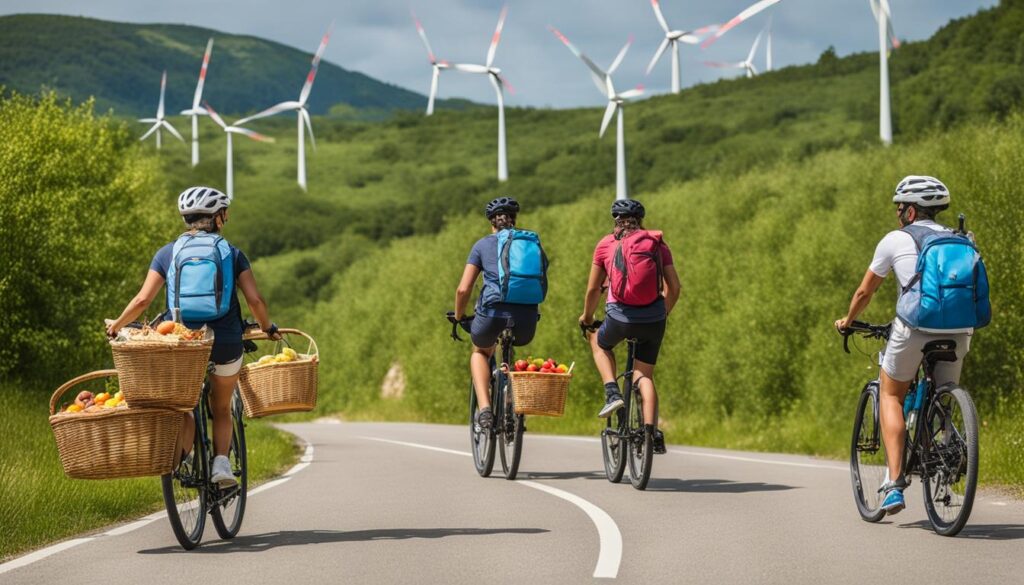If you’re looking to explore the world while minimizing your environmental impact, sustainable travel is the way to go. By adopting eco-friendly practices in your travels, you can contribute to a more sustainable future while still enjoying the beauty the world has to offer. In this article, we will delve into carbon-neutral travel and explore various strategies and tips for achieving sustainable and eco-friendly travel. From reducing your carbon footprint to supporting local communities, there are many ways to make your journeys greener. So, let’s get started on the path to sustainable travel today!
Understanding Carbon-Neutral Travel
Carbon-neutral travel refers to the act of traveling without leaving a carbon footprint or offsetting the carbon emissions produced during the journey. This means reducing greenhouse gas emissions and promoting sustainable practices throughout your trip.
The tourism industry is notorious for its high carbon emissions, with air travel being one of the primary contributors. In fact, the aviation industry accounts for around 2.5% of global greenhouse gas emissions.
Low-carbon travel is a way to mitigate these impacts. It involves using modes of transportation that emit fewer greenhouse gases, such as electric cars, trains, and buses, walking, or cycling. Additionally, choosing eco-friendly accommodations and participating in sustainable activities can further reduce your carbon footprint during your trip.
“Carbon-neutral travel refers to the act of traveling without leaving a carbon footprint or offsetting the carbon emissions produced during the journey.”
The concept of carbon-neutral travel is not just about reducing the carbon emissions during your trip; it’s also about making environmentally-conscious choices both before and after your journey. This includes offsetting your carbon emissions through supporting carbon offset projects, using renewable energy sources, and reducing your overall energy consumption in your daily life.
The Benefits of Sustainable Travel
When you choose sustainable travel options, you’re not only reducing your environmental impact, but you’re also benefiting local communities and promoting responsible tourism. By prioritizing eco-friendly travel practices, you’re helping preserve natural resources and cultural heritage, while also supporting local economies.
One of the most significant benefits of sustainable travel is reducing your carbon footprint. By choosing low-carbon transportation options, such as walking, biking, or public transit, you can significantly reduce your carbon emissions compared to flying or driving alone.
Another advantage of eco-friendly travel is minimizing waste and plastic consumption. When you bring reusable containers and bags, you can avoid single-use plastic products that pollute the environment and harm wildlife.
Furthermore, responsible tourism practices support cultural preservation and community well-being. When you stay at locally-owned accommodations and participate in community-based tours and activities, you’re contributing to the local economy and supporting the livelihoods of residents.
Choose sustainable travel options to reduce your environmental impact, support local communities, and promote responsible tourism.
“Sustainable travel is the best way to preserve natural and cultural heritage while supporting the local economy, which is why we promote eco-friendly travel practices at our company.”
Carbon-Offsetting: A Solution for Carbon-Neutral Travel
If you’re looking for ways to reduce the carbon footprint of your travels, carbon-offsetting is a great option. When you carbon offset, you invest in projects that reduce or remove carbon emissions from the atmosphere. By doing so, you can balance out your own carbon emissions generated by transportation, accommodations, and activities, achieving carbon-neutral travel.
Carbon-offsetting projects may include reforestation, renewable energy development, and other initiatives that promote sustainable practices.
How does carbon-offsetting work?
Suppose you flew from Los Angeles to New York City, generating 2 tons of CO2 emissions in the process. To offset those emissions, you can purchase carbon offsets equivalent to 2 tons of CO2 from a reputable provider. The provider will then use your funds to support a project that reduces or eliminates 2 tons of CO2 emissions elsewhere.
Carbon-offsetting is not a substitute for reducing carbon emissions in your travel practices. Instead, it is a complement to sustainable travel behaviors and an effective tool for mitigating your carbon footprint.
How to carbon-offset your travels?
Several reputable companies offer carbon-offsetting programs. Choose one that aligns with your values and supports projects that contribute to climate change mitigation.
- Calculate your carbon footprint for each trip and purchase offsets equivalent to your emissions.
- Some airlines and travel booking sites may offer carbon offset options during booking.
- Donate to non-profit organizations working on carbon-offsetting projects.
Remember to do your research and choose a reputable provider that verifies and reports on the impact of their offset projects.
“Carbon-offsetting is not an excuse for unsustainable travel practices. It is meant to offset unavoidable emissions and should be combined with eco-friendly travel strategies.”
Choosing Environmentally-Friendly Accommodations
When selecting accommodations for your travels, you can play a crucial role in reducing your environmental impact. Opting for eco-friendly lodging options not only helps you stay in line with your sustainable travel goals but also decreases the negative impact on the planet.
There are various things you can consider when choosing environmentally-friendly accommodations. Some of the key factors include:
- Energy-efficient practices, such as renewable energy sources and water conservation.
- Recycling and composting systems in place.
- The use of natural, non-toxic, and organic cleaning products.
- Avoidance of single-use plastics, such as disposable cups, bottles, and straws.
- Support for local communities and economies, such as employing local staff, sourcing food from local suppliers, and supporting local initiatives.
By taking these factors into account, you can make a conscious decision to choose an accommodation that aligns with your sustainable values.
When booking, don’t hesitate to inquire about the hotel’s sustainability practices and environmental policies. Most eco-friendly accommodation options will proudly share their environmentally-friendly practices with guests.
Additionally, there are several resources available to help you find eco-friendly accommodations, like eco-friendly travel guides and websites that specialize in environmentally-friendly travel options. You may also want to consider staying in eco-lodges or eco-resorts, which are designed to have minimal environmental impact while providing a comfortable stay.
“Sustainable and eco-friendly accommodations can play a crucial role in enabling responsible tourism practices while supporting a more sustainable future for today’s world.”
When you choose eco-friendly accommodations, you are not only reducing your carbon footprint but also supporting a movement towards environmentally-conscious lodging options.
Sustainable Transportation Options
When it comes to sustainable travel, transportation plays a significant role in reducing your carbon footprint. Opting for greener modes of transportation can make a considerable difference in minimizing your environmental impact while exploring new destinations. Here are some sustainable transportation options for your next trip:
- Public transit: Take advantage of local public transportation such as buses, trains, and subways to get around in a climate-conscious way.
- Cycling: If you’re up for some physical activity, consider renting a bike or bringing your own for an eco-friendly and healthy way to explore new places.
- Walking: For shorter distances, walking is the most sustainable and cost-effective way to get around while creating opportunities to immerse in the local culture and scenery.
Additionally, you can reduce your transportation impact by limiting the number of trips or planning your itinerary to minimize travel between distant destinations. Traveling slower between destinations can positively impact the environment, as well as provide a chance to engage more deeply with your surroundings.
Remember, every sustainable travel decision counts. By choosing green transportation options, you can contribute to more sustainable travel and minimize your impact on the environment.
Supporting Local Communities and Businesses
When traveling sustainably, one important aspect to consider is how to support the local communities and businesses of your destination. By doing so, you can help contribute to the economic and cultural well-being of the place you are visiting, promoting responsible tourism practices and rewarding those who prioritize sustainability.
One way to support local businesses is to shop at local markets or stores. This not only supports the local economy but can also reduce your carbon footprint by avoiding products that have been transported over long distances.
Another way to engage with a destination’s local community is to seek out cultural experiences and events organized by local residents. This can include participating in a cooking class led by a local chef, attending a traditional music performance, or visiting a craft fair showcasing handmade products.
Furthermore, it is essential to be respectful and mindful of local customs and cultural norms. This includes dressing appropriately, learning a few basic phrases in the local language, and being aware of social customs when interacting with locals.
Remember to always consult with local tourism organizations or seek recommendations from reputable sources to ensure that your money is going towards sustainable businesses that prioritize responsible tourism practices.
By supporting local communities and businesses, you can have a positive impact on your travel destination while promoting sustainable and responsible tourism practices.
Minimizing Single-Use Plastics
Traveling sustainably involves reducing your impact on the environment and local communities. When it comes to single-use plastics, small actions can make a big difference. These disposable items are a major source of pollution, harming wildlife and ecosystems. Here are some tips for minimizing your use of single-use plastics:
- Bring your reusable water bottle or container instead of buying plastic bottles
- Carry a reusable shopping bag
- Choose products with minimal packaging
- Use a refillable coffee cup
- Refuse straws and other plastic utensils
Many eco-friendly alternatives are available, such as bamboo utensils, metal straws, and silicone storage bags. These items are often lightweight and easy to pack. By incorporating sustainable habits into your travels, you can significantly reduce your carbon footprint and help protect the planet.
“The greatest threat to our planet is the belief that someone else will save it.” – Robert Swan
Engaging in Sustainable Activities and Tours
Exploring the local nature and culture can be an exciting and fulfilling part of travel. By choosing sustainable activities and tours, you can also contribute to responsible tourism and minimize your environmental impact.
- Choose activities that allow you to explore nature and wildlife without disturbing their natural habitats or ecosystems.
- Support local guides and operators who prioritize sustainability and responsible tourism.
- Consider activities that support conservation efforts and contribute to the well-being of local communities.
Check out organizations and initiatives dedicated to promoting responsible tourism, such as Sustainable Travel International and the Global Sustainable Tourism Council. These resources provide information on sustainable activities and tours, making it easier for you to plan your environmentally-friendly trip.
The Role of Education and Awareness
To promote sustainable travel practices, education and awareness play a crucial role. By learning about the impact of travel on the environment and local communities, you can make informed choices and take action to minimize your negative impact. Similarly, by sharing your knowledge and experience with others, you can inspire them to adopt conscious travel practices.
Through initiatives such as community outreach programs and online resources, you can access a wealth of knowledge that can guide you towards sustainable travel practices. Research eco-friendly travel options, such as environmentally-friendly accommodations and transportation alternatives, to support responsible tourism.
Education and awareness also extends to understanding the cultural and environmental sensitivities of the local communities you visit. Respect local customs and traditions, and seek opportunities to engage with and learn from the people and cultures that make your destination unique.
By adopting sustainable travel practices and increasing awareness, we can make a significant impact on preserving our planet and improving the lives of those we encounter during our travels.
Tracking and Measuring Your Travel Footprint
To make your travels carbon-neutral, it’s important to measure and track your carbon footprint. By identifying your emissions, you can take steps to reduce and offset them. Here are some tools and resources to help you track and measure your travel impact:
Carbon Footprint Calculators
Carbon footprint calculators are online tools that help you estimate the carbon emissions generated by your travel activities. They take into account factors such as transportation, accommodation, and activities to give you a comprehensive picture of your impact. Some popular carbon footprint calculators include:
| Tool | Description |
|---|---|
| EcoAct Calculator | A user-friendly calculator that estimates the carbon emissions generated by your travel based on a variety of factors. |
| Cotap Calculator | A comprehensive calculator that allows you to calculate the carbon footprint of your travel as well as your home, food, and other lifestyle activities. |
| TravelnSave Carbon Emissions Calculator | A tool that calculates your travel carbon footprint based on your mode of transportation, distance traveled, and accommodation. |
Using a carbon footprint calculator can help you identify the activities that generate the most emissions, allowing you to take steps to reduce them.
Carbon Offsetting
Carbon offsetting allows you to balance out your carbon emissions by investing in projects that reduce greenhouse gases. These projects can include renewable energy development, reforestation, and improved energy efficiency. Many carbon offset providers offer tools to help you calculate your emissions and select an appropriate offset project.
When choosing a carbon offset provider, look for certifications and standards such as the Gold Standard or Verified Carbon Standard to ensure that your investment is going towards a genuine reduction in emissions.
Tracking Your Progress
Tracking your progress is an important part of achieving carbon-neutral travel. Keep a record of your emissions and the steps you take to reduce them. This can help you see the impact of your actions and inspire you to make further changes.
You can also use travel tracking apps and tools such as TripIt or Google My Maps to map out your travel itinerary and calculate the emissions associated with each activity.
By tracking and measuring your travel footprint, you can take concrete steps towards carbon-neutral travel and a more sustainable future.
Conclusion
Congratulations on taking the first step towards achieving carbon-neutral travel. By implementing sustainable and eco-friendly practices during your journeys, you can contribute to a more sustainable future and minimize your environmental impact on the planet. Remember, every small step you take counts towards a greener and cleaner planet.
We hope that this article has provided you with useful strategies and tips for achieving carbon-neutral travel. By understanding the importance of low-carbon travel, choosing environmentally-friendly accommodations, engaging in sustainable activities, and supporting local communities, you can make your travels more responsible and eco-conscious.
Don’t forget the power of education and awareness in promoting sustainable travel practices. Share your knowledge and experiences with others, and encourage them to adopt eco-friendly behaviors.
Finally, tracking and measuring your travel carbon footprint is essential in monitoring and reducing your environmental impact over time. Use the available tools and resources to stay accountable and make ongoing efforts towards greener travel.
Together, we can create a future where responsible and eco-friendly tourism practices are the norm. Safe and sustainable travels!

















































